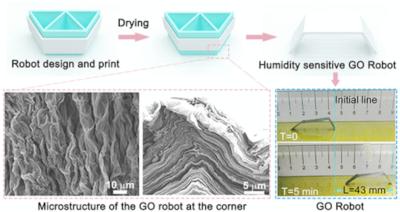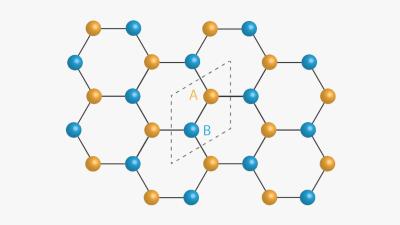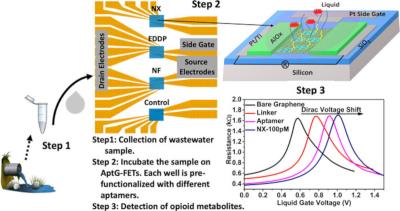The Graphene-Info newsletter ( March 1, 2022)
posted on
Mar 01, 2022 10:04PM

Hydrothermal Graphite Deposit Ammenable for Commercial Graphene Applications

Cannot read this? View it online here
Researchers from the University of Sussex, the University of Brighton and CNRS have developed a way to wrap emulsion droplets with graphene and other 2D materials by reducing the coatings down to atomically-thin nanosheet layers. The team said this could ‘significantly advance’ the new technology area of liquid electronics, enhancing the functionality and sustainability of potential applications in printed electronics, wearable health monitors and even batteries.
The scientists were able to create electrically-conducting liquid emulsions that are the lowest-loading graphene networks ever reported – just 0.001 vol%. This means that the subsequent liquid electronic technology will be both cheaper and more sustainable because it will require less graphene or other 2D nanosheets coating the droplets.
UK-based graphene developer Haydale announced its unaudited interim H1 FY2022 results (the six months that ended on 31 December 2021). The company's revenues were £1.19 million (down from £1.28 million in H1 FY2021) and a loss of £1.75 million (up from £1.08 million last year).
Haydale says that it progressing on many of its functionalisation based nano projects, and its planned delivery of the new HT1400 reactor will git it additional capacity and allow for cost-effective material processing on a large scale. Haydale is also pleased to see the early signs of recovery in the aerospace market and wider cutting tools market.
Graphene producer NanoXplore announced that it is raising $30 million CAD, selling shares to a syndicate of underwriters led by National Bank Financial Inc. and Canaccord Genuity Corp.
NanoXplore says it will use the funds for general corpoate purposes - which may include potential acquisitions. A few months ago the company announced it has acquired Canuck Compounders, a privately held plastic recycling compounder that provides sustainable and engineered recycled plastic compounds.
Researchers from China’s Harbin Institute of Technology have 3D printed a soft robot from graphene-oxide that is capable of moving backward and forwards when exposed to moisture.

The scientists combined Direct Ink Writing (DIW) 3D printing and constrained drying techniques to fabricate the soft robot, and were able to overcome the porosity, shrinkage and structure uniformity challenges previously observed when 3D printing graphene-oxide objects.
Pakistani startup Energy and Automation (ENA) recently joined forces with Jolta Battery, a sister company of Jolta Electric – Pakistan’s First EV company, in an exclusive agreement to work on graphene-based Supercapacitors with an innovative power backup storage technology called “ENARGEZE SUPERPOWER” which is powered by Zoxcell.
ENA’s Chief Executive, Amir Salman, explained that the Supercapacitor is 25 times better than VRLA dry batteries. He said that this new technology is safe to use and minimizes the use of generators. In the bigger picture, this will contribute to a greener Pakistan by reducing carbon footprint and fuel consumption.
Scientists from Princeton, the University of Leeds, the University of California and the National Institute for Material Science in Japan have used innovative techniques to visualize electrons in graphene, and found that strong interactions between electrons in high magnetic fields drive them to form unusual crystal-like structures similar to those first recognized for benzene molecules in the 1860s by chemist August Kekulé.

These crystals exhibit a spatial periodicity that corresponds to electrons being in a quantum superposition. The experiments also showed the Kekulé quantum crystals have defects that have no analog to those of ordinary crystals made up of atoms. These findings shed light on the complex quantum phases electrons can form because of their interaction, which underlies a wide range of phenomena in many materials.
A new initiative has been established, to explore the development of various applications for graphene, from graphene-infused asphalt and concrete to water filtration systems.
To this end, researchers at the U.S. Army Engineer Research and Development Center (ERDC) will be working with top research institutions and experts from the University of Mississippi (UM), Jackson State University (JSU) and Rice University. The collaboration will explore graphene’s unique abilities in uses ranging from advanced materials-by-design to self-sensing infrastructure.
An international team of scientists from the CNR-IFN, Politecnico di Milano, the University of Pisa, the Graphene Center of Cambridge (UK) and the Catalan Institute of Nanoscience and Nanotechnology (ICN2, Barcelona) has shown that the relaxation time of graphene charge carriers can be significantly modified by applying an external electrical field.
After light absorption, graphene's photoexcited charge carriers cool down to the initial equilibrium state in a few picoseconds, corresponding to a millionth of a millionth of a second. The remarkable speed of this relaxation process makes graphene particularly promising for a number of technological applications, including light detectors, sources and modulators.
Researchers from Boston College, Boston University, and Giner Labs have designed a small graphene-based multiplexed bio-sensor that detects opioid byproducts in wastewater.

The novel device uses graphene-based field effect transistors to detect four different synthetic and natural opioids at once, while shielding them from wastewater’s harsh elements. When a specific opioid metabolite attaches to a molecular probe on the graphene, it changes the electrical charge on the graphene. These signals are easily read electronically for each probe attached to the device.
Interworld Electronics has released the BOXER-6641-PRO multi-core embedded controller from Aaeon, with a unique fan-less graphene heat sink chassis design that ensures an unprecedented operating temperature range of -40°C to 70°C.
Graphene-based cooling tech seems to be gaining popularity and is incorporated in various computer components (like MSI's RTX 3000 series GPUs), cellphones (like realme's GT 2 series, ZTE's Axon 30 , Xiaomi's Mi 10 Ultra, various Huawei phones), and more.
Haydale has announced that it has been awarded funding of £168,573 (around USD$226,250) to develop high barrier monolayer films for food packaging by Innovate UK, the UK's innovation agency.
Haydale Composite Solutions Ltd ('HCS'), will lead the consortium of nine companies - BASF, Bangor University, Cambridge Nanomaterials Technologies, Dunbia, Fre-Energy, Parkside Flexibles, Recycling Technologies, and Wells Plastics - to develop the next generation of high barrier films for food packaging using functionalized nanomaterials ("HiBarFilm2 Project"). The HiBarFilm2 Project is due to start in March 2022 and is expected to run for 30 months. It follows the success of the HiBarFilm feasibility study where functionalized nanomaterials were shown to influence barrier performance in films.